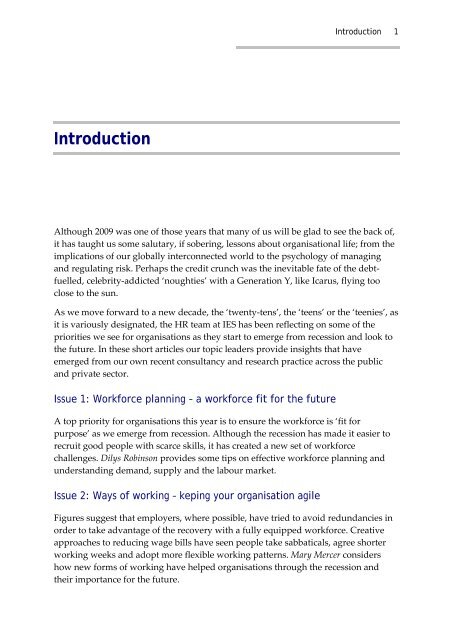PDF of this item - The Institute for Employment Studies
PDF of this item - The Institute for Employment Studies
PDF of this item - The Institute for Employment Studies
- No tags were found...
You also want an ePaper? Increase the reach of your titles
YUMPU automatically turns print PDFs into web optimized ePapers that Google loves.
Introduction 1IntroductionAlthough 2009 was one <strong>of</strong> those years that many <strong>of</strong> us will be glad to see the back <strong>of</strong>,it has taught us some salutary, if sobering, lessons about organisational life; from theimplications <strong>of</strong> our globally interconnected world to the psychology <strong>of</strong> managingand regulating risk. Perhaps the credit crunch was the inevitable fate <strong>of</strong> the debtfuelled,celebrity‐addicted ‘noughties’ with a Generation Y, like Icarus, flying tooclose to the sun.As we move <strong>for</strong>ward to a new decade, the ‘twenty‐tens’, the ‘teens’ or the ‘teenies’, asit is variously designated, the HR team at IES has been reflecting on some <strong>of</strong> thepriorities we see <strong>for</strong> organisations as they start to emerge from recession and look tothe future. In these short articles our topic leaders provide insights that haveemerged from our own recent consultancy and research practice across the publicand private sector.Issue 1: Work<strong>for</strong>ce planning – a work<strong>for</strong>ce fit <strong>for</strong> the futureA top priority <strong>for</strong> organisations <strong>this</strong> year is to ensure the work<strong>for</strong>ce is ‘fit <strong>for</strong>purpose’ as we emerge from recession. Although the recession has made it easier torecruit good people with scarce skills, it has created a new set <strong>of</strong> work<strong>for</strong>cechallenges. Dilys Robinson provides some tips on effective work<strong>for</strong>ce planning andunderstanding demand, supply and the labour market.Issue 2: Ways <strong>of</strong> working – keping your organisation agileFigures suggest that employers, where possible, have tried to avoid redundancies inorder to take advantage <strong>of</strong> the recovery with a fully equipped work<strong>for</strong>ce. Creativeapproaches to reducing wage bills have seen people take sabbaticals, agree shorterworking weeks and adopt more flexible working patterns. Mary Mercer considershow new <strong>for</strong>ms <strong>of</strong> working have helped organisations through the recession andtheir importance <strong>for</strong> the future.
















